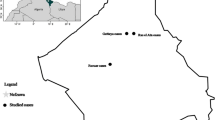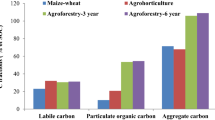Abstract
Land use change has a significant effect on soil organic carbon (SOC), especially on labile organic carbon (LOC) due to its rapid response to soil changes and carbon supply. The objective of the study was to assess the effects of different land uses on soil fraction size distribution, SOC and LOC concentrations and their stocks in karst region of Guizhou Province, Southwest China. Studies were based on soil sampling in paddy, dryland, abandoned cultivated land for 3-years (AC-3), and abandoned cultivated land for 15-years (AC-15) in the 0–10, 10–20, and 20–30 cm depths in karst mountain area of Guizhou Province. Three fraction-size classes [macro (250–2000 μm), micro (53–250 μm), silt + clay (<53 μm)] were fractioned, and SOC and LOC concentrations in whole soil (non-fractionated) and different fraction sizes were also determined. The results showed that paddy contained the highest SOC and LOC concentrations in whole soil and different size-fractions as compared with other land uses down to 30 cm depth. However, the proportions of LOC to SOC were higher in AC-3 than the other land uses, especially pronounced in whole soil, which ranged from 17.5 to 26.3 % in different soil depths. Paddy also contained 23.7 % (100.9 Mg ha−1) more SOC and 17.6 % (19.7 Mg ha−1) more LOC stocks than dryland, whereas the SOC and LOC stocks in AC-15 and dryland were very close to each other in each soil depth. In paddy field, we found that macro-sized fractions contributed the greatest quantities of SOC to whole soil. In addition, paddy had significantly higher SOC stock values in macro-sized fractions than the other land uses in the both 0–10 and 10–20 cm depths. In the present study, there were no obvious increases of SOC and LOC pools among whole soil and different soil size-fractions after 15 years of land abandonment. These results suggest that natural recovery of SOC may take a long time after land abandonment, and paddy could serve as an important land use type for long-term carbon sequestration in karst region of Southwest China.





Similar content being viewed by others
References
Albaladejo J, Ortiz R, Garcia-Franco N, Navarro AR, Almagro M, Pintado JG, Martínez-Mena M (2013) Land use and climate change impacts on soil organic carbon stocks in semi-arid Spain. J Soil Sediment 13:265–277
Arevalo CBM, Bhatti JS, Chang SX, Sidders D (2009) Ecosystem carbon stocks and distribution under different land-uses in north central Alberta, Canada. For Ecol Manage 257:1776–1785
Banger K, Toor GS, Biswas A, Sidhu SS, Sudhir K (2010) Soil organic carbon fractions after 16-years of applications of fertilizer and organic manure in a Typic Rhodalfs in semi-arid tropics. Nutr Cycl Agroecosyst 86:391–399
Batjes NH (1996) Total carbon and nitrogen in the soils of the world. Eur J Soil Sci 47:151–163
Beare MH, Hendrix PF, Coleman DC (1994) Water-stable aggregates and organic matter fractions in conventional- and no-tillage soils. Soil Sci Soc Am J 58:777–786
Blair GJ, Lefroy RDB, Lisle L (1995) Soil C fractions, based on their degree of oxidation and the oxidation and the development of a C management index for agricultural system. Aust J Agron Res 46:1459–1466
Chen CR, Xu ZH (2008) Analysis and behavior of soluble organic nitrogen in forest soils. J Soil Sediment 8:363–378
Chen L, Gong J, Fu B, Huang Z, Huang Y, Gui L (2007) Effect of land use conversion on soil organic carbon sequestration in the loess hilly area, loess plateau of China. Ecol Res 22:641–648
Chen Y, Zhang XD, He HB, Xie HT, YanY ZhuP, Ren J, Wang LC (2010) Carbon and nitrogen pools in different aggregates of a Chinese Mollisol as influenced by long-term fertilization. J Soil Sediment 10:1018–1026
Chen HS, Zhang W, Wang K, Hou Y (2012) Soil organic carbon and total nitrogen as affected by land use types in karst and non-karst areas of northwest Guangxi, China. J Sci Food Agric 92:1086–1093
Conant RT, Paustian K, Elliott ET (2001) Grassland management and conversion into grassland: effects on soil carbon. Ecol Appl 11:343–355
Desjardins T, Folgarait PJ, Pando-Bahuon A, Girardin C, Lavelle P (2006) Soil organic matter dynamics along a rice chronosequence in north-eastern Argentina: evidence from natural 13C abundance and particle size fractionation. Soil Biol Biochem 38:2753–2761
Elliott ET (1986) Aggregate structure and carbon, nitrogen, and phosphorous in native and cultivated soils. Soil Sci Soc Am J 50:627–633
Eswaran H, Van den Berg E, Reich P (1993) Organic carbon in soils of the word. Soil Sci Soc Am J 57:192–194
Guggenberger G, Zech W (1999) Soil organic matter composition under primary forest, pasture, and secondary forest succession, Región Huetar Norte, Costa Rica. For Ecol Manage 124:93–104
Haile SG, Nair VD, Nair PKR (2010) Contribution of trees to carbon storage in soils of silvopastoral systems in Florida, USA. Glob Chang Biol 16:427–438
He XY, Wang KL, Zhang W, Chen ZH, Zhu YG, Chen HS (2008) Positive correlation between soil bacterial metabolic and plant species diversity and bacterial and fungal diversity in a vegetation succession on Karst. Plant Soil 307:123–134
Hu J, Lin X, Yin R, Chu H, Wang J, Zhang H, Cao Z (2008) Comparison of fertility characteristics in paddy soils of different ages in Cixi, Zhejiang. Plant Nutr Fertil Sci 14:673–677
Jandl R, Lindner M, Vesterdal L, Bauwens B, Baritz R, Hagedorn F, Johnson DW, Minkkinen K, Byrne KA (2007) How strongly can forest management influence soil carbon sequestration? Geoderma 137:253–268
Jastrow JD (1996) Soil aggregate formation and accrual of particulate and mineral-associated organic matter. Soil Biol Biochem 28:665–676
Lal R (1993) Tillage effect on soil degradation, soil resilience, soil quality and sustainability. Soil Tillage Res 27:1–8
Lal R (2004) Soil carbon sequestration to mitigate climate change. Geoderma 123:1–22
Luo Y, Sherry R, Zhou XH, Wan SQ (2009) Terrestrial carbon-cycle feedback to climate warming: experimental evidence on plant regulation and impacts of biofuel feedstock harvest. GCB Bioenerg 1:62–74
Luo YJ, Wei CF, Li Y, Ren ZJ, Liao HP (2011) Effects of land use distribution and protection of organic carbon in soil aggregates in karst rocky desertification area. Acta Ecol Sin 31:257–266 (In Chinese)
Nelson DW, Sommers LE (1982) Total carbon, organic carbon and organic matter. In: Page AL (eds) Methods of soil analysis. Part 2. Chemical and microbiological properties. Agronomy monograph, 2nd edn, vol 9. American Society of Agronomy Inc, Madison, pp. 539–577
Olk DC, Brunetti G, Senesi N (2000) Decrease in humification of organic matter with intensified lowland rice cropping: a wet chemical and spectroscopic investigation. Soil Sci Soc Am J 64:1337–1347
Oorts K, Nicolardot B, Merckx R, Richard G, Boizard H (2006) C and N mineralization of undisrupted and disrupted soil from different structure zones of conventional tillage and no-tillage systems in north France. Soil Biol Biochem 38:2576–2586
Pan G, Zhao Q (2005) Study on evolution of organic carbon stock in agricultural soils of China: facing the challenge of global change and food security. Adv Earth Sci 20:384–393 (In Chinese)
Pan G, Li L, Wu L, Zhang X (2003) Storage and sequestration potential of topsoil organic carbon in China’s paddy soils. Glob Chang Biol 10:79–92
Piao SL, Fang JY, Ciais P, Peylin P, Huang Y, Sitch S, Wang T (2009) The carbon balance of terrestrial ecosystems in China. Nature 458:1009-U82
Post WM, Peng TH, Emanuel WR, King AW, Dale VH, DeAngelis DL (1990) The global carbon cycle. Am Sci 78:310–326
Razafimbelo TM, Albrecht A, Oliver R, Chevallier T, Chapuis-Lardy L, Feller C (2008) Aggregate associated-C and physical protection in a tropical clayeysoil under Malagasy conventional and no-tillage systems. Soil Tillage Res 98:140–149
Richter DD, Markewitz D, Trumbore SE, Wells CG (1999) Rapid accumulation and turnover of soil carbon in a re-establishing forest. Nature 400:56–58
Saha SK, Nair RPK, Nair VD, Kumar BM (2010) Carbon storage in relation to soil size-fractions under tropical tree-based land-use systems. Plant Soil 328:433–446
Saha D, Kukal SS, Sharma S (2011) Landuse impacts on SOC fractions and aggregate stability in typic ustochrepts of Northwest India. Plant Soil 339:457–470
Shang ZH, Cao JJ, Guo RY (2012) Effects of cultivation and abandonment on soil carbon content of subalpine meadows, northwest China. J Soil Sediment 12:826–834
Six J, Paustian K, Elliott ET, Combrink C (2000) Soil structure and organic matter:I. Distribution of aggregate size classes and aggregate-associated carbon. Soil Sci Soc Am J 64:681–689
Six J, Conant RT, Paul EA, Paustian K (2002) Stabilization mechanisms of soil organic matter: implications for C-saturation of soils. Plant Soil 241:155–176
Soil Survey Staff in USDA (1992) Keys to soil taxonomy, 5th edn. Pocahontas Press, Ins, Blacksburg
Tiessen H, Stewart JWB (1983) Particle-size fractions and their use in studies of soil organic matter: II., Cultivation effects on organic matter composition in size fractions. Soil Sci Soc Am J 47:509–514
Tisdall JM, Oades JM (1982) Organic matter and water-stable aggregates in soils. J Soil Sci 33:141–163
Trumbore SE, Bonani G, Wolfli W (1990) The rates of carbon cycling in several soils from AMS 14C measurements of fractionated soil organic matter. In: Bouwman AF (ed) Soils and greenhouse effect. Wiley, New York, pp 405–414
Wang SP, Zhou GS, Gao SH, Guo JP (2005) Soil organic carbon and labile carbon along a precipitation gradient and their responses to some environmental changes. Pedosphere 15:676–680
Wang H, Guan DS, Zhang RD, Chen YJ, Hu YT, Xiao L (2014) Soil aggregates and organic carbon affected by the land use change from rice paddy to vegetable field. Ecol Eng 70:206–211
Wei XR, Shao MA, Gale WJ, Zhang XC, Li LH (2013) Dynamics of aggregate-associated organic carbon following conversion of forest to cropland. Soil Biol Biochem 57:876–883
Xu ZH, Chen CR, He JZ, Liu JX (2009) Trends and challenges in soil research 2009: linking global climate change to local long-term forest productivity. J Soil Sediment 9:83–88
Xu X, Sherry RA, Niu S, Zhou JZ, Luo YQ (2012) Long-term experimental warming decreased labile soil organic carbon in a tallgrass prairie. Plant Soil 361:307–315
Yuan HW, Su YR, Zheng H, Huang DY (2007) Distribution characteristics of soil organic carbon and nitrogen in peak-cluster depression land use of karst region. Chin J Ecol 26:1579–1584 (In Chinese)
Zhang D, Wang S, Zhou D (2001) Intrinsic driving mechanism of land rocky desertification in karst regions of Guizhou Province. Bull Soil Water Conserv 4:1–5 (In Chinese)
Zhang W, Parker K, Luo YQ, Wan S, Wallace LL, Hu S (2005) Soil microbial responses to experimental warming and clipping in a tallgrass prairie. Glob Chang Biol 11:266–277
Zhang K, Dang H, Tan S, Cheng X, Zhang Q (2011a) Change in soil organic carbon following the ‘Grain-for-Green’ programme in China. John Wiley &Sons Ltd, pp 13–23
Zhang GS, Chan KY, Li GD, Huang GB (2011b) The effects of stubble retention and tillage practices on surface soil structure and hydraulic conductivity of a loess soil. Acta Ecol Sin 31:298–302
Zhang LH, Xie ZK, Zhao RF (2012) The impact of land use change on soil organic carbon and labile organic carbon stocks in the Longzhong region of Loess Plateau. J Arid Land 4:241–250
Zhou P, Song G, Pan G, Li L, Zhang X (2009) Role of chemical protection by binding to oxyhydrates in SOC sequestration in three typical paddy soils under long-term agro-ecosystem experiments from South China. Geoderma 153:52–60
Zhu ZJ, Jiang PK, Xu QF (2006) Study on the active organic carbon in soil under different types of vegetation. For Res 19:523–526 (In Chinese)
Acknowledgments
This work was supported by the National Natural Science Foundation of China (31360121 and 41461072), Degree and Postgraduate Teaching Reform Project of Guizhou Province, Science and Technology Development Research Program in Guizhou Province(LKS-2012-25), the Fund for Doctor in Guizhou Normal University, and the program from Social Development in Guizhou Province (SY-2013-3162). We are grateful to anonymous reviewers for the constructive comments on the manuscript.
Author information
Authors and Affiliations
Corresponding author
Rights and permissions
About this article
Cite this article
Liao, H., Long, J. & Li, J. Soil organic carbon associated in size-fractions as affected by different land uses in karst region of Guizhou, Southwest China. Environ Earth Sci 74, 6877–6886 (2015). https://doi.org/10.1007/s12665-015-4690-2
Received:
Accepted:
Published:
Issue Date:
DOI: https://doi.org/10.1007/s12665-015-4690-2




